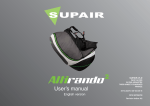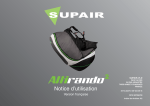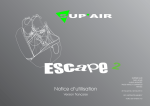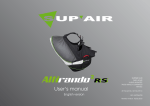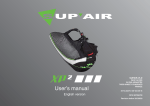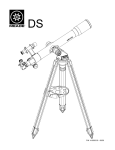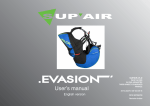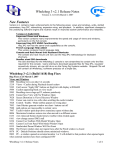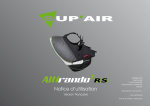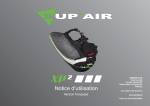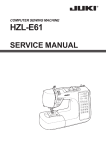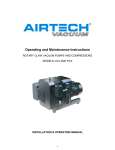Download User's manual
Transcript
SUPAIR-VLD User’s manual English version PARC ALTAÏS 34 RUE ADRASTÉE 74650 ANNECY CHAVANOD FRANCE 45°54.024’N / 06°04.725’ E RCS 387956790 Revision Indice: A3 Thank you for your choice of an ESCAPE 2. We are proud to join you on your journey in our common passion : paragliding. SUP’AIR has been designing, producing and selling accessories for free flying activities since 1984. By choosing a SUP’AIR product you benefit from almost thirty years of expertise, innovation and listening. This is also our philosophy : working endlessly to develop better products and to maintain a high quality production in Europe. We trust that you will find this user’s manual comprehensive, explicit and hopefully pleasant to read. We advise you to read it carefully ! On our website www.supair.com, you will find the last up to date information about this product. If you have any further questions, feel free to ask one of our retailers. And of course, the entire SUP’AIR team are at your disposal through info@supair. com We wish you many safe flying and enjoyable hours, and happy landings The SUP’AIR team 2 List of contents List of contents Introduction Technical specifications Size choice Components Harness overview Backpack mode overall view. FLEX SEAT Sytem presentation About the Airbag Speed-Bar ready ( Optional ). Foot-rest installation (option) Rescue parachute setup assembly. Position setting Flight behavior Pre-Flight control Opening and closing of the Airbag Take-off Complements/Accessories Care Service Book 3 4 5 6 7 8 9 10 11 12 13 14 17 20 21 22 23 25 26 29 Pictures credits : SUP’AIR 3 Introduction Welcome to the trekking and paragliding world ! With the ESCAPE 2 you are equipped with a light and complete product enabling you to widen you mountain flying spectrum. Great comfort, full AirBAg, possibility to connect a front mount reserve parachute container, are the characteristics of a well rounded harness ready to tackle any thermal after a takeoff from where your hiking trail lead you... After reading this manual, we suggest you check your harness by hanging in it before flying. N.B : Three important icons will help you when reading this manual Advice Caution ! Danger !! 4 Technical specifications S M L Pilot size 155-170 cm 165-180 cm 175-190 cm Pilot’s weight Harness weight (+ carabiners+speedbar) 50-70 kg 60-80 kg 70-95 kg 2200g 2350 g 2550 g Technical sheet A Back height (cm) B Leaning setting height (cm) C Seat length (cm) Designed for D Seat width (cm) E Carabiners height (cm) F Hauteur du dos E Hauteur des points B Hauteur réglage de l'inclinaison du dossier F Distance entre les points C Longueur d'assise D Largeur d'assise Back height (cm) 61 65 69 B Leaning setting height (cm) 34 36 38 Seat length (cm) 35 38 41 Seat width (cm) 36 38 40 Carabiners height (cm) 42 42 44 28-49 28-49 28-49 D E F Carabiners distance (cm) Impact damping system : Airbag (Volume) Impact damping system : Bumpair (Thickness) Homologation F E A A C Carabiners distance (cm) A B D C Parapente uniquement Flight : tandem (Pilot- Passenger) Flight : acrobatic flying Take-off : Winching Quick-out carabiners compatibility Yes No EN 1651 & LTF 91/09 passenger only No Yes* No * Refer to towing manual and recommendations. This harness is delivered with two 30 mm Biners ( 138 g. for the set ). An overall weight decrease is possible to obtain by swapping the Biners with a «Connect» set ( 24 g. for the set ). 5 Size choice Choosing your harness’ size is important. You will find here below a height/weight table that will help you in your size choice. Nonetheless we advise you to try out the harness under a hanging device and in different sizes at one of our retailers in order to choose the correct size. For a complete list of our retailers, please click here : www.supair.com Size Weight 50 55 60 65 70 1m45 1m50 1m55 S S S S 1m60 1m65 1m70 S S S S S S S S S 1m75 1m80 1m85 M M M L M L L L L L L L M M M M 75 M M M 80 85 90 95 100 105 110 M M M L L L L 1m90 1m95 2m 2m05 S S/M M M/L L 6 Components 1 1 Rescue parachute handle 2 30 mm Aluminium self-locking biner 2 Options 4 Double stage speed-bar 5 Short foot-rest 6 Front parachute container 4 5 6 7 Harness overview This illustration will help you during your reading. 6 6 6 6 11 1 3 Ventral buckles 2 Safe-T-Bar 3 Thigh strap buckles 4 Ventral width adjustment 5 Leaning setting 6 Shoulders’straps adjustment 7 Dorsal Air-Bag 8 Buckles for foot-rest 4 1 3 3 7 7 9 9 3 8 10 14 1 10 12 13 13 Speed system pulleys. 10 Hiking poles hooking points. 11 Hydration hose passage. 12 Air-Bag locking system 13 Velcros for footrest attachment 14 Zipper puller for Airbag closing 8 Backpack mode overall view. The ESCAPE 2 is a real backpack that combines a good carrying comfort and a complet accessorization. It will help you to plan travels and kike and fly. 6 4 4 2 1 2 2 5 8 3 2 Elastic hiking pole lanyards. 3 Stretchable netted side pockets. 4 Adjustable load distribution straps. 5 Chest strap. 6 Backpack’s volume compression 7 Adjustable waist strap. 8 Adjustable chest straps. 9 Waist strap pocket. 3 1 1 2 7 Compression straps. 6 1 8 1 2 2 10 9 10 10 Ice-Axes holders 9 FLEX SEAT Sytem presentation The Escape 2 revamps the split-leg concept and proposes a hybridization between split-legs and seat plate 1 2 The legs are solidarized like on a seat plate but in a flexible way so that it takes the shape of your thighs. The freedom of movement during take-off is the same but while flying the legs’ movements are not dissociated like on split legs harnesses : they are grouped almost liken on a seat plate harness. Nonetheless the weightshift is less radical than on a seat plate and helps you to have a more stable handling. This is ideal for the hike and fly and also the miniwings and even the speedriding. Morevover the FLEX SEAT provides more comfort than regular split-legs. 3 Last but not least, the FLEX SEAT is associated with direct linking of your thighs thus proposing a natural position (same axis than the flying direction). 3 1 2 2 10 About the Airbag The ESCAPE2 integrates a built-in cushioning protection system named AirBAg in case of a dorsal or buttock landing. It was designed to absorb and dissipate the accumulated energy in case of impact. How does it work? : the Airbag integrated with a few of our harness models is comprised of a fabric envelope shaping two or three caissons. These caissons trap the air channeled in by the relative wind speed via a semi rigid intake stiffened with cables and or flexible materials to facilitate the AirBag inflation ( especially during takeoff ). In case of impact, the air inside the AirBag is compressed then expelled, escaping through the caissons micro-stitching perforation and the air intake. The process brings a progressive decompression and energy dissipation absorbed by the pilot. Warning! : There are energy absorption limitations in case of straight down crash. The AirBag will not protect the user in case of a lateral, frontal or high velocity vertical downward energy impact. Danger ! : If your AirBag was previously impacted, a possible premature wearing and tearing of the fabric could take place and reduce the protector’s integrity and efficiency to meet the required safety criteria. If the case, a visual inspection of the AirBag should be conducted ( stitched lines and fabric ). If any sort of damage is discovered and in need of repairs it will then be necessary to contact your retailer or our customer service department for information on how to proceed. 11 Speed-Bar ready ( Optional ). The ESCAPE 2 is pre-equipped to receive most speed-bar systems found on today’s market. Within the SUP’AIR accelerator product range, the double stage speed system is best suited for being light and self-retractable. B C A A Line. B Locking hook. C Elastic self-retractable speed-system. 1 Push the speed-bar line through the grommet. 2 Push the speed-bar line behind the harness skirt. 3 Push the speed-bar line through the pulley. 4 Fixer à la sellette via l’oeillet métallique cousu au fond de l’assise. 5 Attach the end of the speed-bar line to the crimped hook which is to be connected to the riser’s crimped hook. Adjust the line length and securely knot it. 5 3 1 2 4 12 Foot-rest installation (option) The ESCAPE 2 is pre-equipped to receive a foot-rest. Push the webbing through the buckle located at the front of the harness side skirt. A B A B Short foot-rest. Foot-rest connection loop ( pre-equipped ). 13 Rescue parachute setup assembly. The Escape2 is set-up to receive a front mount reserve parachute container. 1 Connect the front mount reserve parachute container to the right side. 2 Push the reserve parachute risers through the external risers’ flaps alongside the harness. 3 A Rescue Parachute Pocket (with the connection to the harness risers) When you are correctly fitted and all the buckles (chest and thigh straps) are closed, close the plastic buckles around the left carabiner. Push the risers inside the flaps. 1 2 3 A 2 14 Connecting the rescue parachute risers to the harness : Y risers 1. Place the Maillon Rapide® (locking nut upwards and on exterior side) inside the webbing loop. Place the O-ring inside the Maillon and twist it. 1 Maillon Rapide ® Inox 6mm (x2) 2 O-Rings (x2) 3 2. Pass the riser inside the free loop and inside the Maillon Rapide®. 3. Make a new twisted loop with the ring and pass it inside the Maillon Rapide®. 4. Repeat steps #1, #2 and #3 with another O-ring for the connexion to harness. Tighten the Maillon Rapide® locking nut correctly, with a spanner if needed. 5. Neatly stow any surplus risers under the flaps. Parachute risers 15 Connecting the rescue parachute risers to the harness : standard risers 1. Make a lark’s head between the risers and the webbing loop for rescue attachment. 1 Rescue standard parachute risers 2 Webbing loop for rescue risers attachment 2. lark’s 3. Neatly plus risers Fasten head stow under the neatly any surthe flaps. 16 Position setting All harness adjustments must be made prior the first flight during a hang-test session. It is of utmost importance to adopt a proper flying posture, check all basic adjustments and have easy access to in-flight adjustments. 6 1 Chest strap finger-loop tension tightening adjustment. 2 Chest strap finger-loop tension release adjustment. 3 4 5 6 5 5 1 Tightening snapper (leaning setting) 1 2 2 Loosening strap (leaning setting) 3 Tightening snapper (shoulder strap) 4 6 Loosening strap ( shoulder strap) 17 A loosen Leaning angle setting tighten Push up to release. Set the angle of leaning by tightening the snapper (towards a more vertical position) or the black webbing (towards a more horizontal position). You can extend the lumbar support by tightening the #5 buckle. B Shoulders’ straps adjustments. Tighten the shoulder straps by pulling the finger loop down. When adopting a reclined flying posture, the shoulder straps must enhance in-flight comfort levels by supporting the upper back. loosen The shoulder straps support, greatly helps the comfort level. It should be set precisely. You must find the correct tension between the side and shoulder straps adjustments. tighten C Chest strap adjustment. This adjustment is important as it acts on the ABS and the harness overall stability. The tighter the more stable. The opposite is true while enabling weight-shift steering. To tighten the chest strap: Place your left hand in front of and pass the risers to grab the right self-locking Biner. With the right hand, grab the chest strap finger-loop and pull it to tighten the chest strap. To loosen the chest strap: Place your left hand in front of and pass the risers to grab the right self-locking Biner. With the left arm, shorten the distance between the risers and pull the finger-loop in the opposite direction to loosen the chest strap. 18 Reversible Harness / Backpack. How to turn the Altirando2 backpack mode into the harness mode: 1 1 . Completely loosen the backpack’s upper weight distribution straps or the Air-Bag will be pinched at the its top section. 2 . Completely unzip the Air-Bag. 3 . Empty the backpack’s content. 4 . Unfold the seat toward the outside. 5.Zip the Air-Bag and activate the pressure locking system located right onto the harness - designed to fully close the envelope and ensure its proper inflation. 6. Check carefully that the zipper closing for the aribag is in the opened position 2 3 4 6 2 How to turn the ESCAPE 2 backpack mode into the harness mode: 1. Un fasten the snap button that locks the Airbag. 2 . Open the backpack as much as you can. 3 . Fill your backpack. 4 . close the backpack. 5 3 4 1 19 Flight behavior The ESCAPE 2 has a sound and well-balanced behaviour Thanks to the Flex Seat System and to the linking between the thighs, the ESCAPE 2 is very tolerant in turbulent conditions by helping you to stay seating whilst limiting the legs’ movements. Although the ESCAPE 2 is a low weight harness, the comfort provided by the Flex Seat System will surprise you. The lateral skirts by protecting you from the displacement wind will help you if the flying conditions are good to stay in the air higher, further and longer as planned ! 20 Pre-Flight control Conduct a thorough pre-flight check before each takeoff. • • • • • • • Check the harness and Biners integrity. Check that the (optionnal) front parachute pocket is correctly closed. Check that your harness adjustments have not changed. Check the connexion risers / harness as well as the self-locking Biners ( locked and secured ). Check your speed-bar system if your harness is equipped with one. Make certain to close all buckles, pockets and especially the Air-Bag zipper with its locking mechanism. Double check that all buckles are fully locked and secured by pulling firmly on them. Check that no line, tab or cloth is stuck / jammed in the buckles. • Check for the AirBag intake zipper to be fully opened for unobstructed air flow. After a thorough weather conditions analysis, when the decision to fly has been taken, fit into the harness : • Fasten the buckles (thigh straps, safe-T-bar and ventral buckles) with application. • Validez le bon verrouillage des boucles en tirant dessus de chaque côté après fermeture. Veillez à ce qu’aucune sangle, cordelette, suspente ou tissu ne soient “coincé” dans une boucle. • Be absolutely certain that there is not a line or other object in contact with or caught in the reserve parachute handle. 1 1 3 1 4 3 1 2 2 Thigh strap buckles automatic Safe-T-Bar 3 Chest strap buckles 4 AirBag air intake valve. 21 Opening and closing of the Airbag The Escape 2 proposes a very useful function for the groundhandling in the snow or the sand : you can close the air inlet with a zipper, thus making impossible for sand or snow to enter the airbag Please do not forget that if you close this zipper, the Airbag will have no efficiency and will not protect you in case of shock. 1 2 Closing zipper for the Airbag Zipper puller to push through the grommet to check the Airbag inlet is correctly opened 2 1 22 Take-off Takeoff is a simple and straight forward. The transition from running to seating is easy. If the transition is a bit more demanding then, raise your knees and push with your shoulders against the risers while wiggling your waist to help your body slide into the bottom of the seat. Never force yourself into the harness with your toggles in hands. Doing so, could slow the glider down and stall it. Do not release your hands from the brakes when you are close to the ridge. 23 In flight As soon as you are airborne, the behaviour is very instinctive and precise. Please set the distance between the two carabiners according to the aerology and to the wing manufacturer’s recommendations. The average distance / spacing for most gliders from the center of the right Biner to the center of the left Biner where the risers connect, is between 36 cm and 45 cm. Tightening the chest strap provides more stability but less harness piloting efficiency. Doing so, increases the risk of riser twisting. On the contrary, loosening the strap provides more efficiency but can be dangerous in turbulent aerology while increasing the risk of falling towards the collapsed side of your glider and without being able to efficiently counteract the situation. Speedbar use We recommend a careful use of the speedbar because of an increased risk of massive collapse. Please read carefully the manual of your glider. Landing Stand up inside the harness and adopt an upright position in order to run to dissipate horizontal speed. Do not land whilst in the seated position, this is dangerous. N.B. Frequents landings on the Airbag can damage the fabrics and the sewings and may decrease its efficience. 24 Complements/Accessories We propose you optional accessories that combine perfectly to your ALTIRANDO² harness. Function Code Description Code Speed bar ACCELSOUPLE Soft speed bar 100 g Short foot-rest CALEPIED Short foot rest 150 g Front parachute pocket PPVC PPVCLIGH PPVCXTRALITE COCPPVC Front parachute container Light front parachute container X-tralite front parachute container Front parachute + cockpit 560 g 320 g 100 g 660 g All the information for the accessories are provided with the product or are easy to access on our website www.supair.com 25 Care Wash and care of your harness It is a good idea to wash your harness from time to time. To do this, we recommend to use a soft solvent (such as soap), use a brush and rinse thoroughly. In any case, do not use chemicals such as detergents or strong solvent because it may deteriorate the webbing, stitching and fabrics of your harness. The zip fasteners should be lubricated from time to time, using a silicon spray. If your harness gets wet, it is advisable to treat your automatic buckles and carabiners with silicone grease from time to time. Storage and transport When you don’t use your harness, store it inside your paragliding rucksack, in a dry, cool and clean place, protected from UVs exposure. If your harness is wet, please dry it thoroughly before storing. For transport, protect the harness from any mechanical or UV deterioration (use a bag). Please avoid long transports in wet conditions. Controls >> Independently of the pre-flight check-out, you have to open and unfold your rescue parachute once every 6 months. >> An inspection of the harness must be conducted by yourself or preferably by a professional for any structural possible damage every two years. The following areas should be : • • • • The AirBag : no holes or fabric tears ( the AirBag would not be working properly otherwise ), no plastic stiffeners damage. Carbon seat plate : no crack, no asperity. webbings (no excessive wear, no rip beginning, no unwanted folds) buckles and carabiners ( no structural cracks / works fine ). The threads that compose the webbing and fabrics used in the ESCAPE 2 have been selected in order to ensure the best possible lightness/lifetime compromise. Nonetheless, in some conditions, after a long term exposure to UV and/or significant abrasion or exposure to chemicals, it is compulsory to check your harness in a certified repair centre. It is about your safety. These carabiners must never be used for anything else else than paragliding (not for climbing, no towing, etc.). The carabiners must be replaced by new ones every 5 years, or before that date if necessary ( dents or faulting mechanism,.... 26 Repair Though we use the highest quality materials, it is possible that your harness may eventually deteriorate through general use. If its is showing any signs of significant wear and tear, you should check it and repair it in an certified repair centre. SUP’AIR offer a repair facility for their products beyond the end of the warranty period. Please contact us either by telephone or by E-mail [email protected] in order to receive a quotation. Only use original factory parts for repairs. Contact us at [email protected] to order the correct materials. Materials Main Fabrics ARMED CORDURA® RIPSTOP CORDURA® Webbings Polyamide 20 mm (500DaN) Polyester 25 mm (1250 DaN) Recycling All our materials are selected for their technical and environmental characteristics. No components of our harnesses may harm nature. Most of our components are recyclable. If you judge your harness has finished its life, you can separate all the plastic and metallic parts and apply up-to-date sorting rules in effect in your community. For recycling of the fabric parts, we advise you to contact your local authority that deals with fabric recycling. Environmental friendly practices We highly recommend you to respect as much as possible our environment while practicing paragliding and especially : not to go outside tracks, do not make unwanted noise and do not disturb the mountain areas’ balance and respect nature with its fragile environment. 27 Warranty SUP’AIR takes the greatest care in the design and production of its products. SUP’AIR guarantees its products 5 years (from purchase date) against any defect or design fault occurring during normal use. Any damage or degradation resulting from incorrect or abusive use, abnormal exposure to aggressive factors, including, but not limited to; high temperature, intense sun exposure, high humidity etc will invalidate this warranty Disclaimer Paragliding is an activity that requires, skill, specific knowledge and sound judgement. Be careful, learn in certified schools, subscribe an adequate insurance policy as well as a flying license and make sure your skill match the conditions. SUP’AIR cannot be held responsible for your paragliding decisions or activities This SUP’AIR product has been designed exclusively for paragliding. Any other activity such as skydiving or BASE jumping is absolutely forbidden. Pilot’s gear This is essential that you carry a helmet, suitable boots and clothing. Taking a reserve parachute suitable for your weight and correctly connected to your harness is also very important. 28 Service Book This page will help you to record all the life stages of your ESCAPE 2 harness. Serial number : Purchase date Owner’s name Name and stamp of the shop Care Resale Workshop’s name/ Buyer’s name Care Resale Workshop’s name/ Buyer’s name Care Resale Workshop’s name/ Buyer’s name Care Resale Workshop’s name/ Buyer’s name 29 SUPAIR-VLD User’s manual PARC ALTAÏS 34 RUE ADRASTÉE 74650 ANNECY CHAVANOD FRANCE 45°54.024’N / 06°04.725’ E RCS 387956790































